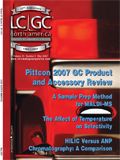Chiral HPLC Columns
Chiral technology has become a very important aspect for scientists involved in the pharmaceutical, chemical, and agricultural industries. The chiral enantiomers can have vitally different pharmacological effects in biological systems. In fact, the U.S. Food and Drug Administration mandates that only therapeutically active isomers must be introduced to the prescription drug market.
Chiral technology has become a very important aspect for scientists involved in the pharmaceutical, chemical, and agricultural industries. The chiral enantiomers can have vitally different pharmacological effects in biological systems. In fact, the U.S. Food and Drug Administration mandates that only therapeutically active isomers must be introduced to the prescription drug market.
Separation of chiral compounds typically is performed using by capillary electrophoresis and chromatographic techniques such as HPLC, GC, and SFC. Scientists also might use a variety of methods to analyze stereoisomers such as polarimetry, NMR, and calorimetry.

2007 chiral HPLC column demand by industry.
In HPLC, there are five types of chiral stationary phases including macrocyclic glycopeptides, cyclodextrins, cellulose/amylose, small molecule, and proteins, which are typically bonded to silica. The elution order of chiral compounds depends upon the formation of transient diastereoisomers due to the interaction with the column packing. The compound that forms the less stable diastereoisomer will elute first.
Chiral chemists can use different solvents, additives, and alter parameters like pH to increase resolution. Temperature plays a key role in separation of chiral compounds. Generally, if the temperature is low enough, it will increase the chiral recognition. However, a temperature that is too low will affect the kinetics of the compound and cause peaks to broaden. Depending upon the class of compounds to be separated, there often is a temperature standard that scientists follow.
According to SDi's estimates, the 2007 market for HPLC chiral columns is about $30–50 million. The pharmaceutical industry is responsible for the majority of the market and is expected to drive future growth. Applications in agriculture and chemical markets also fuel demand.
The foregoing data was extracted and adapted from SDi's High Performance Liquid Chromatography: New Opportunities in a Reinvigorated Market report. For more information, contact Glenn Cudiamat, VP of Research Services, Strategic Directions International, Inc., 6242 Westchester Parkway, Suite 100, Los Angeles, CA 90045, (310) 641-4982, fax: (310) 641-8851, e-mail: cudiamat@strategic-directions.com Web site: www.strategic-directions.com

New Method Explored for the Detection of CECs in Crops Irrigated with Contaminated Water
April 30th 2025This new study presents a validated QuEChERS–LC-MS/MS method for detecting eight persistent, mobile, and toxic substances in escarole, tomatoes, and tomato leaves irrigated with contaminated water.
University of Tasmania Researchers Explore Haloacetic Acid Determiniation in Water with capLC–MS
April 29th 2025Haloacetic acid detection has become important when analyzing drinking and swimming pool water. University of Tasmania researchers have begun applying capillary liquid chromatography as a means of detecting these substances.
Prioritizing Non-Target Screening in LC–HRMS Environmental Sample Analysis
April 28th 2025When analyzing samples using liquid chromatography–high-resolution mass spectrometry, there are various ways the processes can be improved. Researchers created new methods for prioritizing these strategies.

.png&w=3840&q=75)

.png&w=3840&q=75)



.png&w=3840&q=75)



.png&w=3840&q=75)













